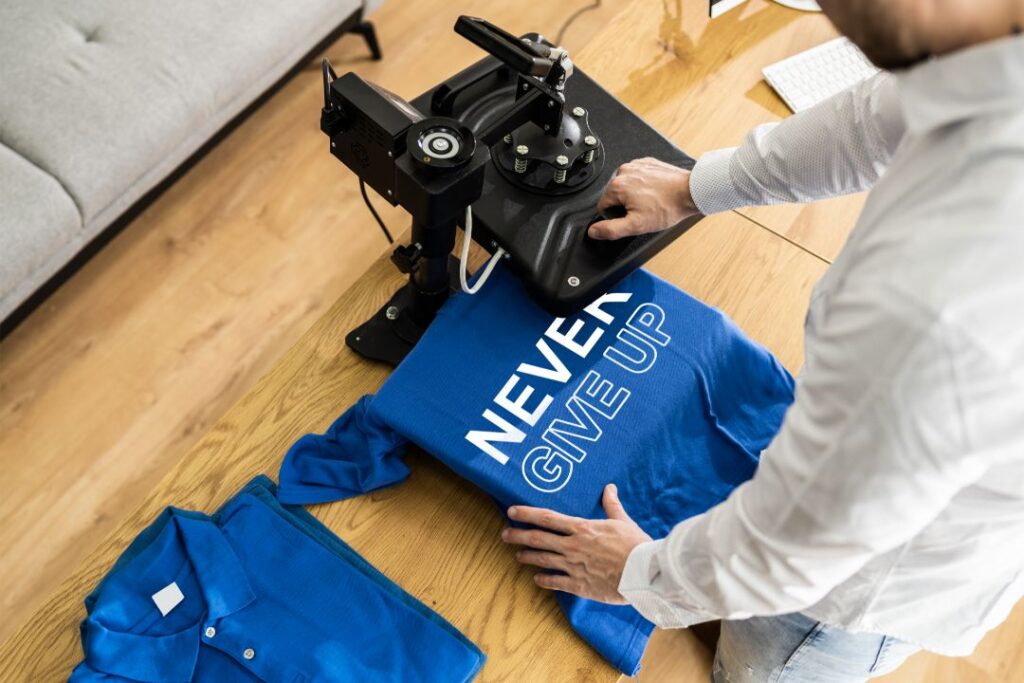
You can make money in print-on-demand (POD) even without design skills. POD allows you to sell custom products (like t-shirts, mugs, or phone cases) without holding inventory—products are printed and shipped only after a sale. Many successful POD entrepreneurs started without any design background. The key is to be resourceful and strategic. Success depends on choosing a niche, leveraging existing designs or tools, effective marketing, and persistence. Below is a detailed guide tailored for non-designers.
1. Understand the Print-on-Demand Model
What is POD? You create or source designs, upload them to a POD platform (e.g., Printful, Redbubble), and list products on marketplaces (e.g., Etsy, Amazon) or your own store (e.g., Shopify). When a customer buys, the POD platform handles printing, shipping, and customer service.
Why it suits non-designers: You can use pre-made designs, hire designers, or use simple tools to create designs without artistic skills.
Potential earnings: Beginners can earn $100–$1,000/month with effort; experienced sellers can scale to $5,000+/month, depending on niche, marketing, and volume.
2. Choose a Profitable Niche
A niche is a specific audience or theme (e.g., dog lovers, gamers, teachers). A focused niche helps you stand out and target marketing effectively.
How to find a niche (no design skills needed)
Brainstorm interests: List hobbies, passions, or communities you’re part of (e.g., fitness, parenting, travel).
Research trends: Use free tools like Google Trends or search Etsy/Amazon for popular products (e.g., “funny cat t-shirts”).
Check social media: Browse X posts, TikTok, or Instagram for trending phrases or slogans (e.g., “Plant Mom” or “Coffee & Chaos”).
Validate demand: Use tools like Merch Informer (for Amazon Merch) or EverBee (for Etsy) to see what’s selling. Look for niches with demand but low competition.
Examples of niches for non-designers: “Proud Nurse,” “Camping Enthusiast,” “Vegan Lifestyle,” “Retro Gaming.”
Tip: Avoid overly broad niches (e.g., “t-shirts”) or trademarked content (e.g., Disney, Nike). Stick to original or generic themes.
3. Source or Create Designs Without Designing
You don’t need to create art yourself. Here’s how to get designs:
Option 1: Use Pre-Made Designs
Where to find them:
- Creative Market: Buy editable design bundles (e.g., quotes, patterns) for $5–$20.
- Etsy: Purchase commercial-use graphics or slogans (search “POD designs”).
- Design Bundles: Offers free and paid design packs with commercial licenses.
How to use: Download designs and upload them directly to POD platforms or tweak them slightly using free tools (see below).
Cost: $0–$50 per design pack (one-time cost, reusable).
Option 2: Use Free Design Tools
Tools for non-designers:
- Canva (Free/Pro): Drag-and-drop editor with templates for t-shirts, mugs, etc. Use pre-made fonts and clipart to create text-based designs (e.g., “Dog Mom Vibes”).
- Photopea (Free): A Photoshop-like tool for basic edits (resizing, layering text).
- GIMP (Free): Open-source software for simple design tweaks.
How to use: Combine pre-made graphics with trendy phrases. For example, add “Teacher Life” text to a free apple graphic.
Time investment: 10–30 minutes per design.
Option 3: Hire Freelance Designers
Where to hire:
- Fiverr: Find designers for $5–$50 per design (search “POD t-shirt design”).
- Upwork: Hire for custom or bulk designs ($10–$100+).
How to brief them: Share your niche, product type (e.g., t-shirt), and examples of similar designs. Request commercial-use rights.
Cost: $5–$50 per design, depending on complexity.
Option 4: Use AI Design Tools
Tools: MidJourney, DALL·E, or Kittl (AI-powered design platform).
How to use: Input prompts like “minimalist coffee mug design with funny quote” to generate designs. Edit in Canva if needed.
Cost: Free or $10–$20/month for premium AI tools.
Tip: Always check the commercial license of designs (pre-made or AI-generated) to ensure you can sell them.
4. Choose a POD Platform
Select a platform to print and fulfill your products. Compare based on product variety, quality, shipping times, and integration with sales channels.
Recommended POD platforms for beginners:
- Printful: High-quality products, integrates with Etsy, Shopify, Amazon. Good for custom branding (e.g., logo on packaging).
- Printify: Wide product range, competitive prices, multiple print providers. Great for testing different items.
- Redbubble: Marketplace where you upload designs, and they handle everything (no upfront costs, but lower margins).
- TeePublic: Similar to Redbubble, good for t-shirts and stickers.
- Gelato: Fast local printing in 32+ countries, eco-friendly options.
How to choose:
- Check product catalogs (e.g., t-shirts, hoodies, mugs, tote bags).
- Compare base costs (e.g., a t-shirt might cost $8–$12 to print).
- Read reviews on X or Reddit for quality and reliability.
- Start with one platform to keep it simple.
Setup process:
- Sign up (free on most platforms).
- Connect to a sales channel (see Step 5).
- Upload designs and create mockups (platforms generate product images).
5. Set Up a Sales Channel
You need a place to sell your products. Here are the best options for non-designers:
Option 1: Marketplaces (Easiest)
- Etsy: Great for handmade/vintage vibes. List products for $0.20 each + transaction fees (6.5% + payment processing).
- Amazon Merch on Demand: Free to join, but approval can take weeks. Ideal for scaling due to Amazon’s traffic.
- Redbubble/TeePublic: Built-in marketplaces; just upload designs and set prices.
- Pros: No need to build a website; platforms drive traffic.
- Cons: Fees and competition.
Option 2: Your Own Store
- Platform: Shopify ($39/month) or WooCommerce (free with hosting).
- Pros: Full control over branding, higher margins, build a customer list.
- Cons: Requires marketing to drive traffic.
- Setup: Use Shopify’s free themes, integrate with Printful/Printify, and add products.
Tip for beginners: Start with Etsy or Redbubble to test designs with minimal investment. Scale to Shopify later.
6. Price Your Products
Pricing affects profitability and competitiveness.
How to price:
- Formula: Base cost (POD platform) + Your profit margin + Platform fees (if any).
- Example: A t-shirt costs $10 to print/ship. You want $10 profit. On Etsy, add ~$2 for fees. Price: $10 + $10 + $2 = $22.
- Research competitors: Check similar products on Etsy/Amazon to ensure your price is competitive (e.g., $20–$30 for t-shirts).
- Redbubble/TeePublic: Set a markup percentage (e.g., 20–30%).
Tip: Offer discounts (e.g., 10% off for first-time buyers) to boost initial sales, but don’t underprice.
7. Market Your Products
Marketing drives sales, especially on your own store. Non-designers can use simple strategies:
Social Media Marketing (Free/Paid)
Platforms: Instagram, TikTok, Pinterest, X.
Strategy:
- Post product mockups with niche hashtags (e.g., #DogLover, #TeacherGift).
- Share relatable content (e.g., memes, quotes) to engage your audience.
- Use X to find trending topics or join niche conversations (e.g., search “camping gear” to find camping fans).
Paid ads: Start with $5–$10/day on Instagram/Facebook Ads targeting your niche (e.g., “women 25–45, interested in yoga”).
Tip: Use Canva to create simple posts or stories.
SEO for Marketplaces
Etsy/Amazon: Use keyword tools like EverBee or Merch Informer to find search terms (e.g., “funny cat mug”). Include them in titles, descriptions, and tags.
Example title: “Funny Cat Lover T-Shirt, Cute Kitty Graphic Tee, Gift for Pet Owners.”
Email Marketing
Tool: Mailchimp (free for up to 500 contacts).
Strategy: Collect emails via your store or Etsy (offer a discount code). Send product updates or holiday promotions.
Influencer Marketing
How: Find micro-influencers (1,000–10,000 followers) in your niche on Instagram/X. Offer free products for promotion.
Cost: $0–$50 per post.
Tip: Start with free methods (social media, SEO) and reinvest profits into ads.
8. Launch and Optimize
Launch: List 10–20 products initially to test your niche and designs. Use mockups from your POD platform for professional listings.
Track performance: Check sales data on your sales channel (Etsy, Shopify) or POD platform. Identify top sellers and create similar designs.
Optimize:
- Update listings with better keywords or photos if sales are slow.
- Test new products (e.g., add hoodies if t-shirts sell well).
- Refresh designs seasonally (e.g., Christmas, Halloween themes).
9. Scale Your Business
Once you have consistent sales, grow your income:
- Add more products: Expand to new niches or product types (e.g., phone cases, posters).
- Increase listings: Aim for 100+ listings on Etsy or Redbubble to boost visibility.
- Outsource: Hire freelancers for designs or virtual assistants for listings.
- Build a brand: Create a logo (via Canva or Fiverr) and consistent style for repeat customers.
- Diversify platforms: Sell on multiple channels (Etsy, Amazon, Shopify) to reduce risk.
10. Manage Finances and Legal Aspects
Track income/expenses: Use tools like QuickBooks or a spreadsheet to monitor profits (sales – POD costs – fees – marketing).
Taxes: Set aside 20–30% of profits for taxes. Consult a local accountant for guidance.
Legal:
- Business license: Check local requirements (often not needed for small-scale POD).
- Trademarks: Avoid using copyrighted phrases or logos. Use tools like USPTO.gov to check trademarks.
- Licenses: Ensure all designs (pre-made or hired) have commercial-use rights.
Tips for Success
Start small: Test 1–2 niches with 10 products before scaling.
Be patient: First sales may take weeks. Focus on improving listings and marketing.
Learn from others: Follow POD sellers on X or YouTube (e.g., “Print on Demand 2025” tutorials).
Stay consistent: Add new designs weekly and market regularly.


